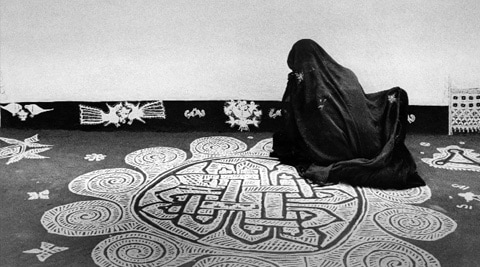Stay updated with the latest - Click here to follow us on Instagram
Art of Living
Photographer Jyoti Bhatt’s exhibition highlights several dying art practices of rural India.
 A woman drawing a mandana design, Rajasthan, 1980.
A woman drawing a mandana design, Rajasthan, 1980.
In 1967, three artistes started collecting representative objects of tribal and rural life for a seminar in Mumbai. They were Bhupen Khakhar, Ghulam Mohammed Sheikh and Baroda-based photographer Jyoti Bhatt. As he framed the objects into images, Bhatt felt that finding the objects was not enough. “Placing them in their original locations, alongside people who make them was equally important,” he says. He also realised that a number of art and craft traditions in the remotest corners of India were quickly becoming extinct. “Forms of visual expressions that I had seen at several places before Independence did not even exist,” he says.
In an effort to preserve these art forms, Bhatt continued his travels to the interiors of Gujarat, Rajasthan, West Bengal, Orissa and Madhya Pradesh for 25 years, seeking out dying art forms and photographing them. Accompanying Bhatt was his artist friend Bhupendra Karia. “We visited some places repeatedly to observe and record changes to those forms,” he says. Now, an exhibition at Institute of Contemporary Indian Art, Kala Ghoda, Mumbai, chronicles some of these efforts through 46 black-and-white photographs. “Jyoti Bhatt: Photographs from Rural India” will travel to Delhi in April after the Mumbai show ends on March 29.
One image shows women in Rajasthan creating white mandana designs on mud-caked walls and floors of their house. The art form is passed on from mother to daughter, and is never taught but learnt. Other photographs — of young girls at prayer in a school in Gujarat, or standing against a village wall in Orissa — also highlight the intricacy of the embroidery-like white work on the walls. Among the most striking images is the one showing two tribal women from Gujarat, carefully painting a man’s face for a local festival. In another, a woman from Rajawar, her whole body inked with elaborate designs, smiles at the camera.
An effort was also made to record the essential steps in the process of creating such art forms. “Unfortunately, video was not an integrated part of still cameras then as it is now, and we could not afford the large video cameras,” Bhatt says. He adds that though black-and-white and colour films were used, the colour transparencies got discoloured beyond repair. Though he wished to capture more practices, Bhatt wanted to focus on one theme.
“I thought ritualistic and secular art forms, usually created by women, using transient materials such a clay, dung, flowers and rice flour needed to be given priority. It was most crucial because such forms were not considered important as ‘National Cultural Treasures’ or ‘Archaeological Heritage’ and their deteriorating condition did not seem to be bothering the government,” he says.







